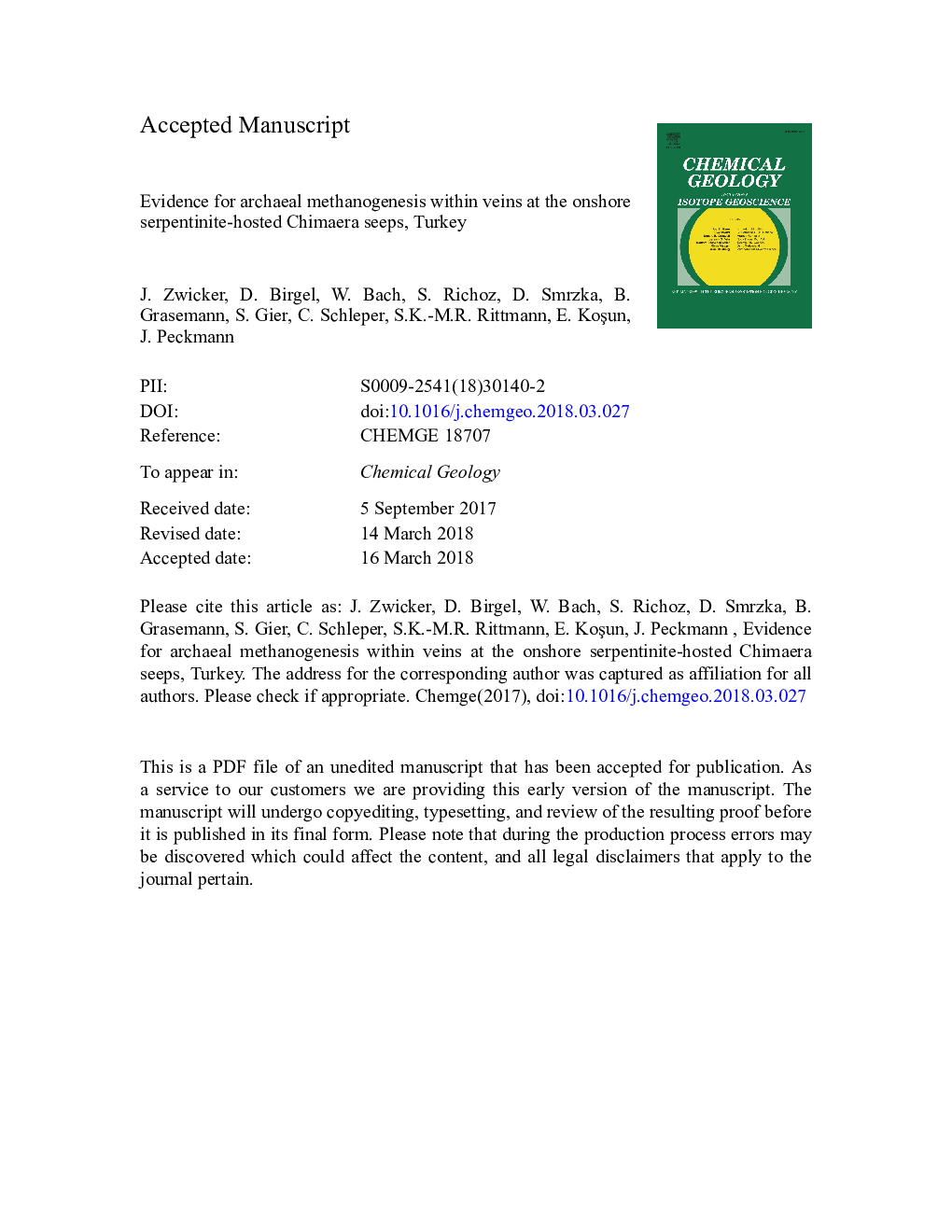| کد مقاله | کد نشریه | سال انتشار | مقاله انگلیسی | نسخه تمام متن |
|---|---|---|---|---|
| 8910313 | 1637491 | 2018 | 49 صفحه PDF | دانلود رایگان |
عنوان انگلیسی مقاله ISI
Evidence for archaeal methanogenesis within veins at the onshore serpentinite-hosted Chimaera seeps, Turkey
دانلود مقاله + سفارش ترجمه
دانلود مقاله ISI انگلیسی
رایگان برای ایرانیان
کلمات کلیدی
موضوعات مرتبط
مهندسی و علوم پایه
علوم زمین و سیارات
ژئوشیمی و پترولوژی
پیش نمایش صفحه اول مقاله

چکیده انگلیسی
Serpentinite-hosted ecosystems are potential sites where life may first have evolved on Earth. Serpentinization reactions produce strongly reducing and highly alkaline fluids that are typified by high concentrations of molecular hydrogen (H2) and methane (CH4), which can be used as an energy source by chemosynthetic life. Low-temperature serpentinization at slow-spreading mid-ocean ridges provides an ideal environment for rich microbial communities. Similar environments have also been discovered on land, where present-day low temperature serpentinization occurs during the circulation of groundwater through exposed ophiolites, triggering the production of CH4 and H2, as well as the precipitation of secondary carbonate minerals. The rock samples analyzed here are from the Chimaera seeps in Turkey, representing serpentinized peridotites that are cross-cut by veins composed of brucite and hydromagnesite. Hydromagnesite features a mean δ13C value of â19.8â° caused by kinetic isotope fractionation during air-groundwater exchange of CO2, followed by CO2 hydroxylation to bicarbonate within the groundwater. Geochemical modeling revealed that mixing of Mg- and Ca-rich groundwaters is required for hydromagnesite formation at the expense of brucite. Within the carbonate-hydroxide veins the lipid biomarkers pentamethylicosane (PMI) and squalane with δ13C values of +10â° and +14â°, respectively, and unsaturated derivatives thereof were identified. Archaeol, sn2-hydroxyarchaeol, and sn3-hydroxyarchaeol are other prominent archaeal biomarkers in the veins, also revealing high δ13C values from +6 to +13â°. These isotope patterns combined with the absence of crocetane - a biomarker for methanotrophic archaea - reveal that the microbial communities of the Chimaera seeps performed methanogenesis from a CO2-limited pool rather than methanotrophy. Moreover, bacterial dialkyl glycerol diethers (DAGEs) with unusually high δ13C values (â9 to â2â°) and minor monoalkyl glycerol monoethers (MAGEs) were identified, suggesting that bacterial sulfate reduction is also active at the Chimaera site. This study reveals that archaeal methanogenesis and bacterial sulfate reduction may be prominent at onshore peridotite-hosted sites, and that biogenic CH4 may contribute to abiotic CH4 emissions from terrestrial seeps.
ناشر
Database: Elsevier - ScienceDirect (ساینس دایرکت)
Journal: Chemical Geology - Volume 483, 20 April 2018, Pages 567-580
Journal: Chemical Geology - Volume 483, 20 April 2018, Pages 567-580
نویسندگان
J. Zwicker, D. Birgel, W. Bach, S. Richoz, D. Smrzka, B. Grasemann, S. Gier, C. Schleper, S.K.-M.R. Rittmann, E. KoÅun, J. Peckmann,